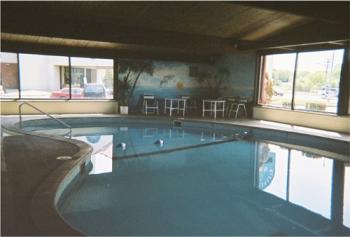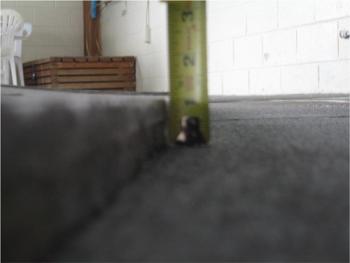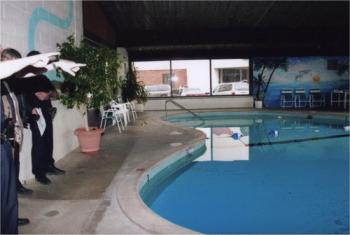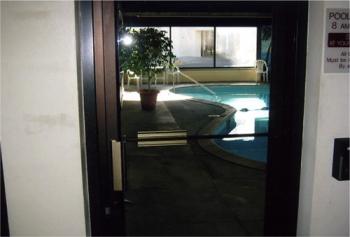Mary J. Reid, et al v. Graebner Enterprises, Inc.




Jordan Reid, his wife Mary J. Reid, and their four children arrived in Milwaukee on Wednesday, May 17, 2006, and checked into room #564 of the Hospitality Inn, located at 4400 S. 27th St. in Milwaukee, WI. They were there to attend Mr. Reid’s family reunion.
On the evening prior to this incident, Mrs. Reid took her five-year-old son (Nate Zamora) to the building “A” swimming pool to go swimming. This pool was located in the same building as their hotel room. The pool in building “A” had a maximum depth of 5’. Nate expressed an interest that day to go see the other hotel swimming pool in building “B”.
Mrs. Reid left the hotel the morning of May 19, along with her 13-year-old daughter (Azalee Macias) to get her hair done. Upon their return to the hotel, while pulling into the parking lot, she noticed some commotion around building “B” with people going into and out of the pool area. She then exited her car and entered the pool area where she observed her husband (Jordan Reid) and her son, Nate, lying motionless on the pool deck.
Building “B” Swimming Pool
The pool is a kidney-shaped pool in a room located off the north building, referred to as the “B” building. The swimming pool ranges in depth from 3’ to 9’ deep and is divided by a lifeline and painted depth line with a steep slope of the pool floor beyond the the breakpoint. The pool is located inside a room and a guest room key is required to access the pool area and swimming pool.
Description
On the day of the incident (May 19, 2006), Josepfina Lopez, Sandra Vanessa Soto-Rodriguez, and Julia Ochoa, employees in the Housekeeping Department for the Hospitality Inn, while walking past the building “B” swimming pool observed two small children in the shallow end of the pool who appeared to be unattended. The women then entered the pool to investigate. As they entered the pool area, they observed Jordan Reid and his son, Nate Zamora, motionless on the pool bottom. While Ms. Lopez and Ms. Ochoa gathered the two young children and got them out of the water, Ms. Soto-Rodriguez attempted to radio for help but was unable to do so from within the pool area. Ms. Soto-Rodriguez then exited the pool building and began calling for help over the radio.
Victoriano A. Orosco and Jack A. Peters, maintenance workers for the Hospitality Inn, while in or around the lobby area in building “A” heard a frantic call over the radio regarding an emergency at the “B” building pool. At the same time, Daniel Slapczynski (General Manager) and Thomas M. Graebner (Owner) were in the main office located in building “A”. Mr. Slapczynski also saw someone running out of building “B” and then heard some emotional chatter on the radio and when he asked for clarification, he was able to make out there was some type of problem in the swimming pool within the “B” building. While all this happened, Mindy Habel (Sales Manager) had been at the front desk and Sarah Jakubowski (Sales Manager) was in her office. After hearing frantic calls on the radio, Ms. Habel looked out the window and saw Mr. Peters running towards the “B” building swimming pool.
Mr. Orosco was the first to arrive into the pool area, immediately followed by Mr. Peters. Mr. Slapczynski, Mr. Graener, and Ms. Jakubowski ran out towards building “B” and entered the swimming pool area through a maintenance door that led into the “B” building and swimming pool and arrived shortly after Mr. Orosco and Mr. Peters. Upon their arrival into the swimming pool area, they observed Jordan and his son, Nate, both submerged on the bottom of the pool. Mr. Orosco immediately jumped into the swimming pool and rescued Nate from the bottom, while Mr. Peters and Mr. Graebner entered the water in an attempt to rescue Jordan. Nate was removed from the pool and placed on the deck. Mr. Peters pulled Jordan to the surface and with the help of Mr. Graebner was able to pull him out of the water and onto the deck. While this was all going on, Mr. Slapczynski used his cell phone to call 911.
When Mrs. Reid returned to the hotel from the hairdresser, as she pulled into the parking lot, she observed some commotion going on with people running in and out of building “B” through the door that led into the swimming pool area. She then parked the car and went to investigate to see if she could be of some assistance. As Mrs. Reid entered the room, Nate was being removed from the pool and placed on the pool deck.
Ms. Habel had stayed at the front desk for a little while. But, when she didn’t hear from anyone and no one returned to the front desk, she then “proceeded to go next door” after she made sure that Veronica was okay at the desk by herself. By the time she arrived into the pool area, Mrs. Reid was already in the pool area with her son, Nate, and Mr. Orosco was with Jordan.
Emergency Life Support
Once Mr. Graebner climbed out of the swimming pool, Jordan was laying face down on the pool deck. According to Mr. Graebner, he attempted to resuscitate Jordan by “pumping his back”. After Jordan expelled “a lot of water and blood”, according to Mr. Graebner, he and Mr. Orosco turned Jordan over, and then “we started pumping on his chest, or Victor did.”
Upon entering the swimming pool area and observing Nate being removed from the swimming pool, Mrs. Reid immediately went to him and assessed him to be in respiratory and cardiac arrest. She immediately initiated the administration of CPR to Nate and continued CPR until Fire EMS personnel arrived on the scene.
When Ms. Habel arrived into the swimming pool area, she observed Mrs. Reid and Sarah Jakubowski with Nate and Mr. Orosco was working on Jordan. Ms. Habel then went to Jordan and “tilted his head”. But, because he was regurgitating and his jaw was locked, all she could do was wipe off his face with a towel.
While Mrs. Reid was attempting to resuscitate Nate, she tried to communicate with whoever was with Jordan to perform CPR on him the way she was resuscitating Nate. But, instead of compressing Jordan’s chest, the person was compressing his stomach. During the administration of CPR on Nate, he started gasping and appeared to be breathing on his own, so Mrs. Reid went over to attempt resuscitation on Jordan. However, Nate stopped breathing again, so Mrs. Reid went back to her son and continued attempting to resuscitate him.
Fire (Engine #17) and EMS (Med #18 and Med #15) units were dispatched to the scene at 11:42 hrs. and arrived at the scene at approximately 11:51 hrs. Upon arrival of Engine #17, firefighters administered CPR to Jordan and Nate until the arrival of ACLS Med Units #18 and #15.
Nate was assessed by Med #15 to be unresponsive, but was breathing on his own following the administration of CPR by Mrs. Reid and the firefighters. Nate had vomited and aspirated fluids into his airway and lungs and remained responsive only to painful stimuli. ACLS protocols were administered and maintained and he was transported to Children’s Hospital.
Med Unit #18 administered ACLS protocols on Jordan for approximately 30 minutes during which time he remained unresponsive and in full cardiac arrest. Jordan Reid was eventually pronounced dead at the scene at 12:16 hrs.
The following were opined to be the breaches in the Standard of Care:
- Failure to monitor the “B” building swimming pool to determine when the pool was being used by hotel guests
- Failure to install an emergency alert alarm or “panic button” in the swimming pool area in order to alert front desk personnel of an emergency within the “B” swimming pool.
- Failure to develop Emergency Action Plans (EPAs) and to rehearse these plans for emergency incidents occurring within the swimming pool areas and swimming pools.
- Failure to develop Emergency Response Plans (ERPs) and to rehearse these plans for emergency incidents occurring within the swimming pool areas and swimming pools.
- Failure to provide CPR training for hotel employees.
- Failure to have CPR trained employees present during the hours the swimming pools are open to guests.
- Failure to have emergency resuscitation equipment available for use in the response to respiratory and cardiac emergencies.
- Failure to have an Automated External Defibrillator (AED) available for use in the response to cardiac emergencies.
- Failure to prevent this incident by informing/educating guests how to effectively respond to an emergency in the swimming pool area.
- Failure to recognize this incident, or its potential, since there was no lifeguard, no attendant, or any type of passive monitoring system deployed within the swimming pool and the surrounding area.
- Failure to effectively manage this incident as there was no one on staff trained in CPR; there was no emergency resuscitation equipment or protocols; and there was no AED available.
- Failure to conduct a Threat Assessment of the hotel’s swimming pools and operating system to identify the physical hazards that existed and the risks associated with swimming in the hotel pools without a lifeguard, an attendant, or a passive monitoring system in place.
- Failure to assess the physical trip hazard associated with the edge of the coping around the perimeter of the swimming pool in that it was elevated off the deck and not flush with the deck, putting patrons at risk of tripping or falling.
- Failure to implement appropriate layers of protection to delay or limit access into the deep water from the shallow water section of the pool; and the possible failure to have a lifeline in place prior to and at the time of this incident to separate the shallow section from the deep section of the swimming pool.
- Failure to establish appropriate Standard Operating Procedures (SOPs) or Standard Operating Guidelines (SOGs) for hotel employees to regularly and routinely inspect and/or monitor the swimming pool areas for problems.
- Failure to establish appropriate Facility Use Guidelines for their guests to educate them about safe practices in the swimming pool and pool area, as well as emergency procedures to be implemented should they be necessary.
- Failure to install and position the lifeline 1 to 2 feet on the shallow side of the depth line and breakpoint of the pool bottom.
- Failure to adequately identify the emergency telephone within the pool area.
- Failure to assess the physical hazard caused by having the entrance door into the pool area nearest the deep end of the pool and the risk this posed to patrons/guests gaining entrance into the swimming pool area.
- Failure to inform guests that maximum depth in the “B” building swimming pool (9’) is not the same as that in the “A” building swimming pool (5’).
- Failure to install an active or passive monitoring system of the swimming pool area, as well as within the swimming pool itself to alert hotel staff of a medical emergency within the pool area, or an immersion or submersion incident within the swimming pool.


